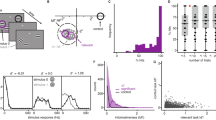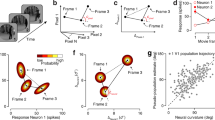Abstract
Neuronal responses at early stages in visual cortical processing, including those in primary visual cortex (V1), are subject to the influences of visual context, experience and attention. Here we show that for monkeys trained in a shape discrimination task, V1 neurons took on novel functional properties related to the attributes of the trained shapes. Furthermore, these properties depended on the perceptual task being performed; neurons responded very differently to an identical visual stimulus under different visual discrimination tasks. These top-down influences were seen from the very beginning and throughout the entire time course of the neural responses. Information theoretic analysis showed that neurons carried more information about a stimulus attribute when the animals were performing a task related to that attribute. Our findings suggest that the output from V1 reflects both sensory and behavioral context.
This is a preview of subscription content, access via your institution
Access options
Subscribe to this journal
Receive 12 print issues and online access
$209.00 per year
only $17.42 per issue
Buy this article
- Purchase on Springer Link
- Instant access to full article PDF
Prices may be subject to local taxes which are calculated during checkout







Similar content being viewed by others
References
McKee, S.P. & Westheimer, G. Improvement in vernier acuity with practice. Percept. Psychophys. 24, 258–262 (1978).
Poggio, T., Fahle, M. & Edelman, S. Fast perceptual learning in visual hyperacuity. Science 256, 1018–1021 (1992).
Saarinen, J. & Levi, D.M. Perceptual learning in vernier acuity: what is learned? Vision Res. 35, 519–527 (1995).
Crist, R.E., Kapadia, M.K., Westheimer, G. & Gilbert, C.D. Perceptual learning of spatial localization: specificity for orientation, position, and context. J. Neurophysiol. 78, 2889–2894 (1997).
Vogels, R. & Orban, G.A. The effect of practice on the oblique effect in line orientation judgments. Vision Res. 25, 1679–1687 (1985).
Shiu, L.P. & Pashler, H. Improvement in line orientation discrimination is retinally local but dependent on cognitive set. Percept. Psychophys. 52, 582–588 (1992).
Ball, K. & Sekuler, R. A specific and enduring improvement in visual motion discrimination. Science 218, 697–698 (1982).
Fiorentini, A. & Berardi, N. Perceptual learning specific for orientation and spatial frequency. Nature 287, 43–44 (1980).
Karni, A. & Sagi, D. Where practice makes perfect in texture discrimination: evidence for primary visual cortex plasticity. Proc. Natl. Acad. Sci. USA 88, 4966–4970 (1991).
Ramachandran, V.S. & Braddick, O. Orientation-specific learning in stereopsis. Perception 2, 371–376 (1973).
Fendick, M. & Westheimer, G. Effects of practice and the separation of test targets on foveal and peripheral stereoacuity. Vision Res. 23, 145–150 (1983).
Gilbert, C.D. Adult cortical dynamics. Physiol. Rev. 78, 467–485 (1998).
Weinberger, N.M. & Bakin, J.S. Learning-induced physiological memory in adult primary auditory cortex: receptive fields plasticity, model, and mechanisms. Audiol. Neuro-Otol. 3, 145–167 (1998).
Recanzone, G.H., Merzenich, M.M., Jenkins, W.M., Grajski, K.A. & Dinse, H.R. Topographic reorganization of the hand representation in cortical area 3b owl monkeys trained in a frequency-discrimination task. J. Neurophysiol. 67, 1031–1056 (1992).
Recanzone, G.H., Schreiner, C.E. & Merzenich, M.M. Plasticity in the frequency representation of primary auditory cortex following discrimination training in adult owl monkeys. J. Neurosci. 13, 87–103 (1993).
Crist, R.E., Li, W. & Gilbert, C.D. Learning to see: experience and attention in primary visual cortex. Nat. Neurosci. 4, 519–525 (2001).
Ghose, G.M., Yang, T. & Maunsell, J.H. Physiological correlates of perceptual learning in monkey V1 and V2. J. Neurophysiol. 87, 1867–1888 (2002).
Schoups, A., Vogels, R., Qian, N. & Orban, G. Practising orientation identification improves orientation coding in V1 neurons. Nature 412, 549–553 (2001).
Blakemore, C. & Tobin, E.A. Lateral inhibition between orientation detectors in the cat's visual cortex. Exp. Brain Res. 15, 439–440 (1972).
DeAngelis, G.C., Freeman, R.D. & Ohzawa, I. Length and width tuning of neurons in the cat's primary visual cortex. J. Neurophysiol. 71, 347–374 (1994).
Gilbert, C.D. & Wiesel, T.N. The influence of contextual stimuli on the orientation selectivity of cells in primary visual cortex of the cat. Vision Res. 30, 1689–1701 (1990).
Kapadia, M.K., Ito, M., Gilbert, C.D. & Westheimer, G. Improvement in visual sensitivity by changes in local context: parallel studies in human observers and in V1 of alert monkeys. Neuron 15, 843–856 (1995).
Knierim, J.J. & Van Essen, D.C. Neuronal responses to static texture patterns in area V1 of the alert macaque monkey. J. Neurophysiol. 67, 961–980 (1992).
Lamme, V.A. The neurophysiology of figure-ground segregation in primary visual cortex. J. Neurosci. 15, 1605–1615 (1995).
Li, C.Y. & Li, W. Extensive integration field beyond the classical receptive field of cat's striate cortical neurons—classification and tuning properties. Vision Res. 34, 2337–2355 (1994).
Li, W., Thier, P. & Wehrhahn, C. Contextual influence on orientation discrimination of humans and responses of neurons in V1 of alert monkeys. J. Neurophysiol. 83, 941–954 (2000).
Maffei, L. & Fiorentini, A. The unresponsive regions of visual cortical receptive fields. Vision Res. 16, 1131–1139 (1976).
Nelson, J.I. & Frost, B.J. Orientation-selective inhibition from beyond the classic visual receptive field. Brain Res. 139, 359–365 (1978).
Rossi, A.F., Rittenhouse, C.D. & Paradiso, M.A. The representation of brightness in primary visual cortex. Science 273, 1104–1107 (1996).
Haenny, P.E. & Schiller, P.H. State dependent activity in monkey visual cortex. I. Single cell activity in V1 and V4 on visual tasks. Exp. Brain Res. 69, 225–244 (1988).
Motter, B.C. Focal attention produces spatially selective processing in visual cortical areas V1, V2, and V4 in the presence of competing stimuli. J. Neurophysiol. 70, 909–919 (1993).
Roelfsema, P.R., Lamme, V.A. & Spekreijse, H. Object-based attention in the primary visual cortex of the macaque monkey. Nature 395, 376–381 (1998).
Ito, M. & Gilbert, C.D. Attention modulates contextual influences in the primary visual cortex of alert monkeys. Neuron 22, 593–604 (1999).
Shannon, C.E. A mathematical theory of communication. Bell Syst. Tech. J. 27, 379–423 (1948).
Poggio, G.F. Mechanisms of stereopsis in monkey visual cortex. Cereb. Cortex 5, 193–204 (1995).
Desimone, R. & Duncan, J. Neural mechanisms of selective visual attention. Annu. Rev. Neurosci. 18, 193–222 (1995).
Kastner, S. & Ungerleider, L.G. Mechanisms of visual attention in the human cortex. Annu. Rev. Neurosci. 23, 315–341 (2000).
Treue, S. Neural correlates of attention in primate visual cortex. Trends Neurosci. 24, 295–300 (2001).
McAdams, C.J. & Maunsell, J.H. Effects of attention on orientation-tuning functions of single neurons in macaque cortical area V4. J. Neurosci. 19, 431–441 (1999).
Treue, S. & Martinez, T.J. Feature-based attention influences motion processing gain in macaque visual cortex. Nature 399, 575–579 (1999).
Sigman, M. & Gilbert, C.D. Learning to find a shape. Nat. Neurosci. 3, 264–269 (2000).
Finney, D.J. Probit Analysis: A Statistical Treatment of the Sigmoid Response Curve (Cambridge University Press, Cambridge, 1952).
Panzeri, S. & Treves, A. Analytical estimates of limited sampling biases in different information measures. Comput.. Neural. Syst. 7, 87–107 (1996).
Acknowledgements
This work was supported by US National Institutes of Health grant EY07968. We are grateful to K. Matsuda for generously sharing the eye tracking software and G. Reeke for valuable comments on the data analysis with information theory. We also thank J. Jones, K. Hazleton and N. Lingenhol for technical assistance.
Author information
Authors and Affiliations
Corresponding author
Ethics declarations
Competing interests
The authors declare no competing financial interests.
Rights and permissions
About this article
Cite this article
Li, W., Piëch, V. & Gilbert, C. Perceptual learning and top-down influences in primary visual cortex. Nat Neurosci 7, 651–657 (2004). https://doi.org/10.1038/nn1255
Received:
Accepted:
Published:
Issue Date:
DOI: https://doi.org/10.1038/nn1255
This article is cited by
-
Continuous multiplexed population representations of task context in the mouse primary visual cortex
Nature Communications (2023)
-
Multisensory Exercise Improves Balance in People with Balance Disorders: A Systematic Review
Current Medical Science (2021)
-
Effects of a Brief Mindfulness-Based Attentional Intervention on Threat-Related Perceptual Decision-Making
Mindfulness (2021)
-
Perceptual learning in the identification of lung cancer in chest radiographs
Cognitive Research: Principles and Implications (2020)
-
Improved fidelity of orientation perception: a learning effect dissociable from enhanced discriminability
Scientific Reports (2020)



